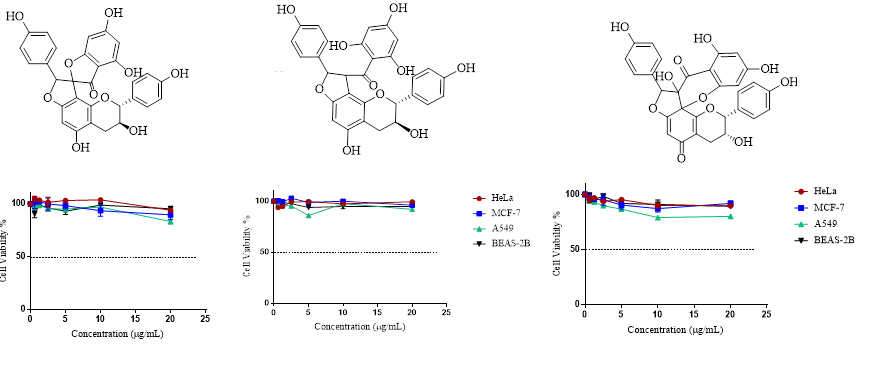JOURNAL 963
Records of Natural Products
Year: 2019 Issue: 3 May-June
p.189 - 198
Viewed 4231 times.
-
Esra Emerce, Perihan Gürbüz, Şengül Dilem Doğan, Ela Kadioglu and Ipek Süntar
GRAPHICAL ABSTRACT

ABSTRACT
Among the plant secondary metabolites much attention has been given to naturally occurring phenolic compounds as attractive candidates for cancer treatment and prevention. Fumana procumbens (Dunal) Gren. & Godr (Cistaceae) is a perennial herb, distributed in inner and southwest Anatolia, Turkey. F. procumbens was shown to be rich in phenolic constituents especially flavonoids and biflavonoids which are known for their antioxidant and anticarcinogenic effects. Thus, this study aims to investigate the anticancer activity of F. procumbens extracts, fractions and pure compounds by MTT test against HeLa, MCF-7, and A549 as well as BEAS-2B cell lines for determining selectivity. Bioactivity-guided phytochemical investigation on Fumana procumbens (Dunal) Gren. & Godr. led to the isolation and identification of three biflavonoids: genkwanol A, dihydrodaphnodorin B and stelleranol. The structures were elucidated by extensive 1D- and 2D-NMR spectroscopic analysis in combination with MS experiments. This is the first report on the isolation of genkwanol A and stelleranol from the genus Fumana and from the family Cistaceae. As a result, no individual cytotoxic activity was obtained for biflavonoid compounds. However, the former fractions FrC and FrD as well as MeOH and n-BuOH extracts exerted moderate and significant cytotoxic activity which suggested a possible synergistic effect.
KEYWORDS- Anticancer activity
- Cistaceae
- Fumana procumbens
- cell viability
- cytotoxicity
- MTT test.